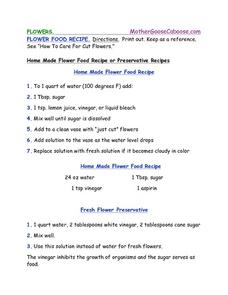Curated OER
Make Your Own Recipe
Students make their own recipe. In this art lesson, students mix dry ingredients with a little water and see the changes made.
Curated OER
Mixed Media Ocean Art
Students design pictures of ocean environments. In this art lesson, students use mixed media art materials to develop a picture that depicts the ocean environment. They use paint, sand paper and various basic art materials.
American Chemical Society
Investigating the Line
Note that this instructional activity is best paired with the preceding instructional activity in the unit. In that instructional activity, elementary physical scientists observed that the color coating of M&Ms® candies do not mix...
DiscoverE
Slime!!
Who's going to get slimed? Your entire class! Scholars create slime using Borax, water, and white glue. Some food coloring can give the slime a bit of color.
Curated OER
Color Mixing
Students have cups of different colored water. They add a new color by using a medicine dropper and see how new colors are formed.
Curated OER
I See a Rainbow
Students identify the different colors in a rainbow. They experiment with dropping food coloring into a water and then making ice cubes. They discuss what happens to the water in the freezer
Curated OER
Rainbow Electrophoresis
Students are introduced to the principles of gel electrophoresis and also provides an opportunity for students to practice loading gels and prpetting. In this laboratory activity, food color is used to separate into constituent pigments.
Serendip
Photosynthesis and Cellular Respiration
How does energy from the sun make plants grow? Scholars move step by step through the processes that promote plant propagation during a detailed lesson. The resource illustrates ADP production and hydrolysis, then allows learners to...
Curated OER
Water Quality Monitoring
Students comprehend the four parameters of water quality. They perform tests for salinity, dissolved oxygen, pH and clarity or turbidity. Students comprehend why scientists and environmental managers monitor water uality and aquatic...
Curated OER
Water Density Boundaries
Students create observable layers in water that represent a separation based upon density differences. They model density boundaries using differences in temperature and salinity. They, in groups, perform a meaningful experiment...
Curated OER
Coffee Filter Eggs
Students make coffee filter eggs. In this art activity, students cut coffee filters into egg shapes. Food coloring is added to water and students drop the colors onto the eggs using a eyedropper. Students allow the filters to dry and...
Curated OER
Reuse, Reduce, Recycle Paper
Young scholars experiment with recycling paper. In this paper recycling instructional activity, students conduct an experiment in which they dissolve newspaper in water and cornstarch to make new pieces of paper. They add color or...
Curated OER
Sand and Water
Students follow this recipe for fun clay creations. In this early childhood art and science lesson, students develop creative-thinking skills, fine-motor skills, and sensory awareness while they make, mold, and decorate salt dough.
Curated OER
Mixing Colors
Students listen to a story about mixing colors. They explore color using cups of water, color and coffee filters. They use sight word vocabulary to describe the colors.
Curated OER
Colored Clouds
Fourth graders, in groups, examine how particles in warm water move faster than particles in cold water.
Curated OER
Flower Food
In this flower learning exercise, students create home made flower preservatives. Ingredients include water, sugar, lemon juice, vinegar, or liquid bleach.
Curated OER
Liquids of Different Densities
Learners compare the densities of different liquids. In this liquids lesson plan, students compare color, viscosity, weight, volume, and graph their findings.
Curated OER
Color Mixing Cookie Exercise
Sixth graders explore how primary colors create secondary colors. They incorporate their knowledge of primary and secondary colors by creating various colors of frosting. Given the cookie shape, they complete a decoration plan for...
Curated OER
Water
In this water instructional activity, students compare and contrast elements and compounds. Students define chemical symbols, chemical formulas, and chemical properties. This instructional activity has 19 short answer questions.
Curated OER
Science: Water States
First graders investigate the various forms of water. They discuss the properties of water. They discover examples of water's various states and locate other solids, liquids, and gases in their homes.
Curated OER
Oxygen
Students explore oxygen and its physical and chemical propeties. In this investigative lesson students complete several experiments using oxygen.
Curated OER
New Jersey Estuaries
Students experiment to discover that salt water is denser than fresh water by creating color coded solutions. They examine how heavy rainstorms and high tides develop layers of different degrees of density.
Curated OER
Salinity Experiment
In this salinity experiment activity, students follow the procedures to set up an experiment about how salinity affects the weight of water.
Curated OER
Design Motifs and Eggs
Students create an Easter egg that displays at least one secondary color, one primary color, and one motif of design.

























